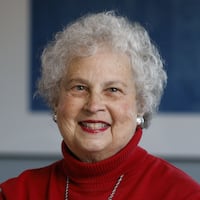For the most part, Muslim leaders in our area say life here is good, with an opportunity to practice their religion freely. But there are challenges as well. A just-released national survey from the Pew Research Center shows that the public continues to express conflicted views of Islam.
About 1 percent of Ohio’s population now self-identifies as Muslim, according to the U.S. Religious Landscape Survey conducted by the Pew Forum on Religion & Public Life. The poll, taken Aug. 19-22, found that opinions about Islam are less favorable than in the summer of 2005.
Wayel and Ramzieh Azmeh, board members of The Mercy Society/Islamic Center of Dayton in Miamisburg, estimate there are now about 10,000 Muslims in the Greater Dayton area. Because Muslims do not “join” houses of worship but are free to visit any mosque, they say statistics are not readily available.
The Azmehs, who are originally from Syria, say the Muslim population in Dayton can best be described as a “mosaic.”
“To name a few, you have people from Jordan, Palestine, Egypt, Morocco, Pakistan, Libya, India and Turkey,” Wayel says.
Judy Atlagh, 34, describes life in the Miami Valley for Muslim families as a “pleasant experience.” She and her husband and children moved to Miamisburg, in part to be closer to the Islamic Center of Dayton. Atlagh, a convert raised in a Protestant family, frequently speaks about her religion at local colleges.
“I cover,” she explains, estimating that about half of the Muslim women in our area expose only their faces and hands when they go out in public as prescribed by the Koran.
Their friends, she says, are a “mixture” of all kinds of people. She’s home-schooling her kids — partly because she worries about the lack of discipline in the public schools today and partly due to concern about prejudice.
Her concerns are not unfounded, according to Karen Dabdoub, executive director of the Southern Ohio chapter of the Council on American-Islamic Relations (CAIR). While there have been no reported hate crimes in this area, she says she is receiving reports of discrimination in both employment and in the schools.
“I don’t get as many calls in Dayton, but what’s disturbing is that more recently it is coming from the teachers who are making statements in class denigrating all Muslims with a kid sitting there who is Muslim,” Dabdoub says.
According to the 2007 Pew survey of Muslims in the United States, one-quarter say they have been the victim of discrimination, 26 percent said others had acted as if they were suspicious of them and 10 percent were “very worried” about not being hired or promoted because of their religion. Fifty-three percent of those polled said that it had been more difficult being a Muslim since 9/11.
Dabdoub says Muslims are a growing population — both in this area and everywhere in the country. That’s partly due to immigration, partly to conversion and partly due to births.
Formerly the administrator of the large mosque in West Chester, Dabdoub said her experiences in this area have been “overwhelmingly positive.”
“There are more good people,” she believes. “Midwesterners in general are very polite people.”
Atlagh, a Stebbens High School grad who got involved with the Muslim community in Baltimore when she was sent there as a travel nurse, has only experienced prejudice once.
“One time I was at the store and someone told me to go back to my own country,” she said. “I just smiled because she was uninformed and ignorant. In Islam, a smile is charity, a kindness toward other people.”
The most virulent example of local prejudice occurred over the building of a mosque in Sugarcreek Twp.
Though the issue has been resolved and the building of the mosque was ultimately approved, Township administrator Barry Tiffany said the initial public meeting was “terrible.”
“It got pretty inflamed and the residents were derogatory in their comments about mosques,” he says. “There were negative comments made about the Muslim religion. It was uncomfortable.”
Awad Halabi, who teaches Islam at Wright State University, says in the past the opposition to the buildings of mosques — as in Sugarcreek Twp. — was based on legal arguments and zoning regulations.
“There was a certain amount of pretense that we live in a tolerant society and we’re not against Islam, but now all that pretense seems to have been dropped,” he observes, predicting that the mood of the country is only going to intensify.
“It’s an experience all immigrant communities go through,” Halabi observes. “You’re going to have more Muslims in government, more demanding to build mosques, charitable organizations and schools, and they’ll be working within the legal and governmental institutions. As long as they kept Islam private, it wasn’t an issue, but now that it is becoming public, it is becoming more controversial. The Dayton community needs to be committed to the laws that it has framed on these types of issues.”
Wayel Azmeh is concerned about Islamaphobia.
“People are not afraid of Muslims, but of Islam” he says. “I think there is a vicious campaign that is trying to divide Americans and portray American Muslims as people who want to hurt their country.”
Ramzieh Azmeh, a pediatrician, says she wants people to know that the violence that has been committed by people who call themselves Muslim is outside of the norm of Islam as she knows and practices it.
Judy Atlagh says America is a learning experience.
“We’re all here, we’re all different, and we have to learn to get along.”
Contact this reporter at (937) 225-2440 or mmoss@DaytonDailyNews.com
About the Author

